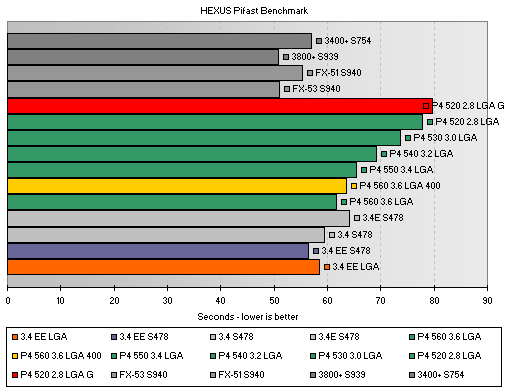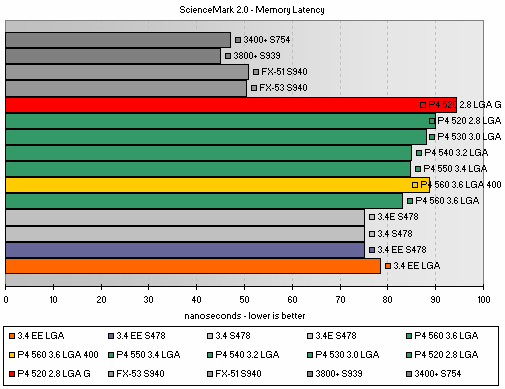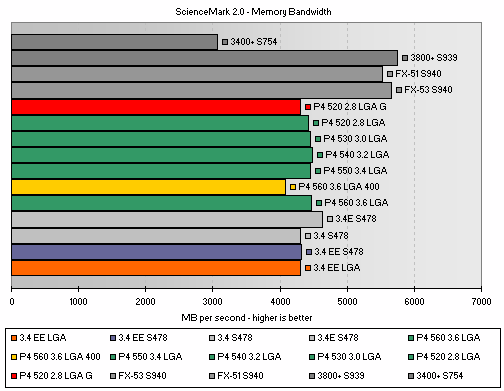Memory Tests

The memory tests, Pifast combined with Sciencemark analysis, give a decent overview of what's happening at the memory subsystem level. It gets interesting here, since the LGA775 processors are accessing DDR-II main memory at less than stellar latencies. Keep a close eye on what happens when the memory speed is dropped from 533MHz to 400MHz with the Pentium 4 560 (3.6GHz), along with the Pentium 4 520 (2.8GHz) memory performance on both Alderwood and Grantsdale.
We're looking to see what access latencies are like on LGA775 with DDR-II, to see if the inevitable performance hit is tolerable. The memory bandwidth at 400MHz and 533MHz will tell us how efficient the memory controller is, and the delta between Alderwood and Grantsdale will show up the PAT-like enhancements, since latencies are identical on each.
Refer to the colour key at the top of the page for easy at-a-glance identification of the processor(s) you're most interested in, to save you squinting at the graphs. The colours are the same on each graph, helping you spot the CPU you want easily, if you're not taking in all the numbers.
Pifast first.
Pifast

Straight away a few things become obvious. Alderwood is indeed faster than Grantsdale at the same memory latencies, highlighting the PAT-like enhancements in Intel's new memory controllers. It will be interesting to see if the enhancements will be usable on Grantsdale retail boards, much like Springdale can use them now.
Secondly, Prescott on LGA775 is slightly slower at the same clock speed as its S478 brethren, due to memory access latencies. Both Prescott package versions can't keep up, memory subsystem wise, with the Northwood version of the CPU at the same clocks, due to architectural advantages in the Northwood Netburst core. Witness the scaling of the 3.4GHz CPUs (disregarding the Extreme Editions just now) as they transition from Northwood to Prescott, then to LGA775 on Prescott, with DDR-II memory. There's a definite access penalty there due to the new DRAM type.
That shows up again with the 3.4 Extreme Edition on LGA775 being a good chunk slower than its S478 brother.
Lastly, while 400MHz DDR-II is a match for the processor bus in terms of bandwidth, since the memory controllers aren't 100% efficient, the 533MHz DDR-II performance is noticeably better.
Those are the key trends in the memory subsystem performance. The rule of thumb is DDR-I has better performance than DDR-II at the same frequency, due to access latency, with 533MHz DDR-II preferable to 400MHz DDR-II at the same latencies. Combine that with Alderwood being faster than Grantsdale at the same clocks and you've got the full picture.
The AMD64 processors chew up Pifast and spit it out much quicker than the Pentium 4 processors ever do. Here's why, from a memory perspective.
ScienceMark 2.0 - Measuring Access Latency

We use ScienceMark 2.0 to measure access latency when the CPU has to go out to main memory for its data, leaving any internal cache accesses behind, save for some memory address lookup.
All the processors on Canterwood (3.4EE, 3.4E, 3.4) access main memory at the same latency, a fine measurement that that particular memory controller is working well. With Alderwood and the 5xx-series processors, access latency scales with CPU speed, since the CPU is doing the accessing. The 3.4EE on Alderwood shows an access penalty compared to the same CPU on Canterwood, with extra time needed for Alderwood at 400MHz, and also with Grantsdale compared to Alderwood. We're seeing the exact pattern witnessed with Pifast, all the rules still hold fast.
Memory bandwidth is the final main piece of the memory puzzle.
ScienceMark 2.0 - Measuring Memory Bandwidth

Processors based on the Northwood or Gallatin-2M cores share the same pipeline depth and therefore have the same memory bandwidth due to ScienceMark's memory bandwidth measuring algorithms. The Prescott core CPUs do a little better with ~4.4GB/sec available on Alderwood at 533MHz and 4.6GB/sec on Canterwood. We also see the predicted drop-offs when at 400MHz on Alderwood and at full speed on Grantsdale, its memory controller not supplying data the CPU as fast as that on Alderwood.
It's a nice picture how memory controller and CPU architecture changes can impact available memory bandwidth.
Overall, running on Alderwood or Grantsdale, you definitely want 533MHz DDR-II for best performance.









